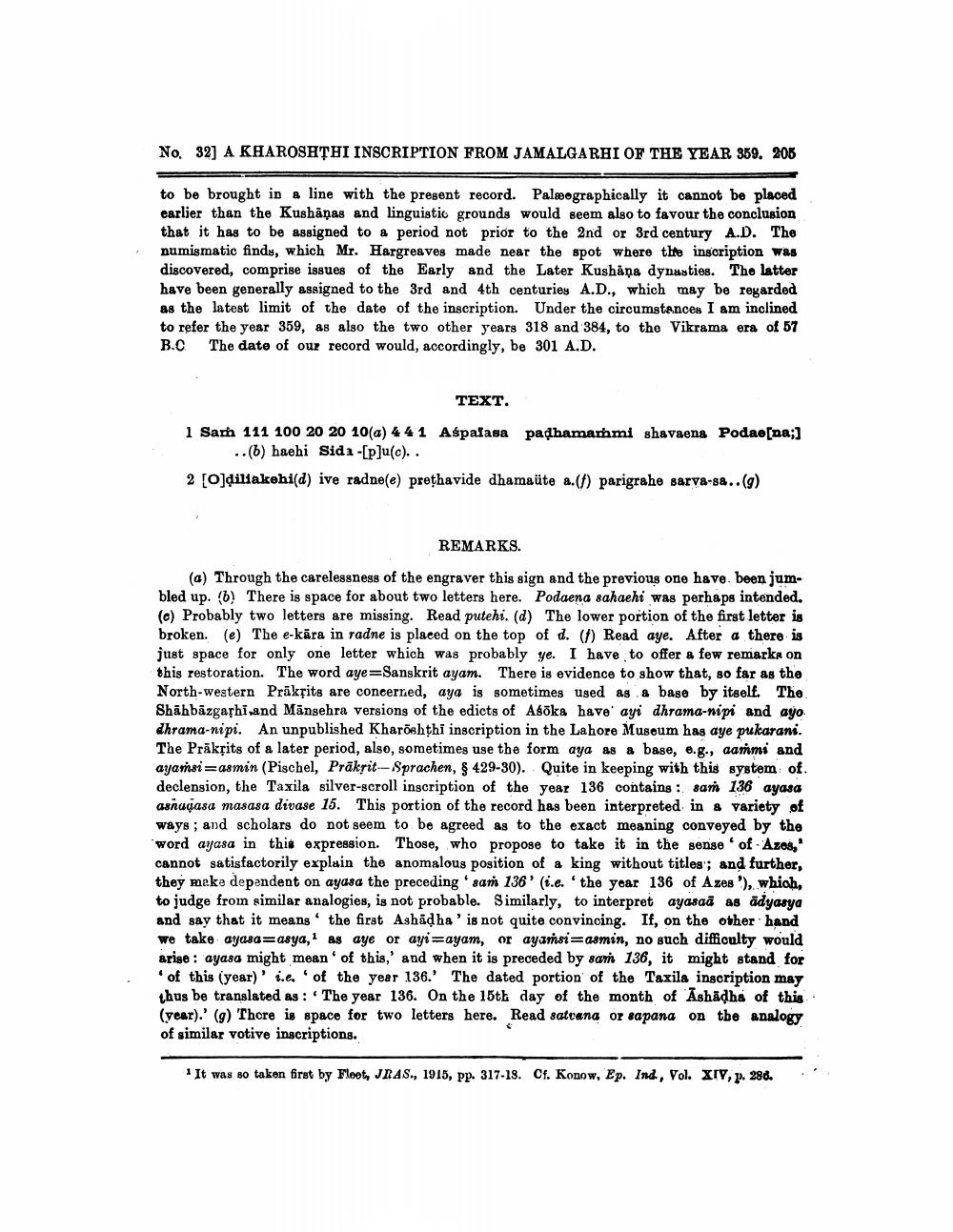________________
No. 32] A KHAROSHTHI INSCRIPTION FROM JAMALGARHI OF THE YEAR 359. 206
to be brought in a line with the present record. Palæographically it cannot be placed earlier than the Kushānas and linguistic grounds would seem also to favour the conclusion that it has to be assigned to a period not prior to the 2nd or 3rd century A.D. The numismatic finds, which Mr. Hargreaves made near the spot where the inscription was discovered, comprise issues of the Early and the Later Kushåņa dynasties. The latter have been generally assigned to the 3rd and 4th centuries A.D., which may be regarded as the latest limit of the date of the inscription. Under the circumstances I am inclined to refer the year 359, as also the two other years 318 and 384, to the Vikrama era of 57 B.C The date of our record would, accordingly, be 301 A.D.
TEXT.
1 Sam 111 100 20 20 10(a) 4 41 Aspalasa padhamammi shavaena Podae[na;]
.. (6) haehi Sida - [p]u(c).. 2 [O]diliakehi(d) ive radne(e) prethavide dhamaüte a.(t) parigrahe sarva-sa.. (g)
REMARKS.
(a) Through the carelessness of the engraver this sign and the previous one have been jumbled up. (b) There is space for about two letters here. Podaena sahaehi was perhaps intended. (c) Probably two letters are missing. Read putehi. (d) The lower portion of the first letter is broken. (e) The e-kāra in radne is placed on the top of d. (t) Read aye. After a there is just space for only one letter which was probably ye. I have to offer a few remarka on this restoration. The word aye=Sanskrit ayam. There is evidence to show that, so far as the North-western Prākṣits are concerned, aya is sometimes used as a base by itself. The Shābbāzgashi and Māngehra versions of the edicts of Asoka have ayi dhrama-nipi and ayo dhrama-nipi. An unpublished Kharöshthi inscription in the Lahore Museum has aye pukarani. The Prākļits of a later period, also, sometimes use the form aya as a base, e.g., aańmi and ayamsi=asmin (Pigchel, Prākrit--Sprachen, § 429-30). Quite in keeping with this system of. declension, the Taxila silver-scroll inscription of the year 136 contains : sar 136 ayasa asnagasa masasa divase 15. This portion of the record has been interpreted in & variety of ways; and scholars do not seem to be agreed as to the exact meaning conveyed by the word ayasa in this expression. Those, who propose to take it in the sense of Azes, cannot satisfactorily explain the anomalous position of a king without titles'; and further, they make dependent on ayasa the precedingsan 136' (i.e. 'the year 136 of Azes'), which, to judge from similar analogies, is not probable. Similarly, to interpret ayasaā as adyasya and say that it means the first Ashādha' is not quite convincing. If, on the other hand we take ayasa=asya, a8 aye or ayi=ayam, or ayamsi=asmin, no such difficulty would arise : ayasa might mean of this,' and when it is preceded by sar 136, it might stand for
of this year) ' i.e. of the year 136. The dated portion of the Taxila inscription may thus be translated as : The year 136. On the 15th day of the month of Ashādha of this (year).' (g) There is space for two letters here. Read satvana or sapana on the analogy of similar votive inscriptions.
* It was so taken first by Floot, JRAS., 1915, pp. 317-18. Cf. Konow, Ep. Ind., Vol. XIV, p. 288.
.




